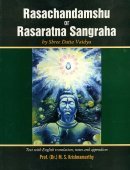Vidradhi, Vidradhī: 11 definitions
Introduction:
Vidradhi means something in Hinduism, Sanskrit, Marathi. If you want to know the exact meaning, history, etymology or English translation of this term then check out the descriptions on this page. Add your comment or reference to a book if you want to contribute to this summary article.
In Hinduism
Ayurveda (science of life)
Toxicology (Study and Treatment of poison)
Source: Shodhganga: Kasyapa Samhita—Text on Visha ChikitsaVidradhi (विद्रधि) refers to “abscess”, as described in the Kāśyapa Saṃhitā: an ancient Sanskrit text from the Pāñcarātra tradition dealing with both Tantra and Viṣacikitsā—an important topic from Āyurveda which deals with the study of Toxicology (Viṣavidyā or Sarpavidyā).—According to the Kaśyapasaṃhita verse V.64, the śakti aspect of Garuḍa is invoked to remove poisons, inflammation, abscess (vidradhi) and infections like Erysipelas.
Unclassified Ayurveda definitions
Source: Wisdom Library: Āyurveda and botanyVidradhi (विद्रधि) refers to “an abscess ”, and is used throughout Ayurvedic literature such as the Caraka-saṃhitā and the Suśruta-saṃhitā.
Source: Research Gate: Internal applications of Vatsanabha (Aconitum ferox wall)Vidradhi (विद्रधि) refers to “boil” (also called a furuncle: a deep folliculitis, infection of the hair follicle). Vatsanābha (Aconitum ferox), although categorized as sthāvara-viṣa (vegetable poisons), has been extensively used in ayurvedic pharmacopoeia.
Source: gurumukhi.ru: Ayurveda glossary of termsVidradhi (विद्रधि):—Abcess

Āyurveda (आयुर्वेद, ayurveda) is a branch of Indian science dealing with medicine, herbalism, taxology, anatomy, surgery, alchemy and related topics. Traditional practice of Āyurveda in ancient India dates back to at least the first millenium BC. Literature is commonly written in Sanskrit using various poetic metres.
Languages of India and abroad
Marathi-English dictionary
Source: DDSA: The Molesworth Marathi and English Dictionaryvidradhi (विद्रधि).—S Phlegmonous inflammation; any deepseated abscess. The classification is of vātajavi0, pittajavi0, kaphajavi0, raktajavi0, kṣatajavi0, tridōṣavi0.
Marathi is an Indo-European language having over 70 million native speakers people in (predominantly) Maharashtra India. Marathi, like many other Indo-Aryan languages, evolved from early forms of Prakrit, which itself is a subset of Sanskrit, one of the most ancient languages of the world.
Sanskrit dictionary
Source: DDSA: The practical Sanskrit-English dictionaryVidradhi (विद्रधि).—An abscess; त्वग्रक्तमांसमेदांसि प्रदूष्यास्थिसमाश्रिताः । दोषाः शोथं शनैर्घोरं जनयन्त्युच्छ्रिता मृशम् ॥ महामूलं रुजापन्नं वृत्तं वाप्यथ वायतम् । स विद्रधिरिति ख्यातो विज्ञेयः षड्विधश्च सः (tvagraktamāṃsamedāṃsi pradūṣyāsthisamāśritāḥ | doṣāḥ śothaṃ śanairghoraṃ janayantyucchritā mṛśam || mahāmūlaṃ rujāpannaṃ vṛttaṃ vāpyatha vāyatam | sa vidradhiriti khyāto vijñeyaḥ ṣaḍvidhaśca saḥ) || Bhāva P.
Derivable forms: vidradhiḥ (विद्रधिः).
Source: Cologne Digital Sanskrit Dictionaries: Shabda-Sagara Sanskrit-English DictionaryVidradhi (विद्रधि).—m.
(-dhiḥ) Phlegmonoid inflammation; especially deep-seated, or internal abscess. E. vidra piercing, dhā to have, ki aff.
Source: Cologne Digital Sanskrit Dictionaries: Monier-Williams Sanskrit-English DictionaryVidradhi (विद्रधि):—[=vi-dradhi] [from vidra] f. (said to be [from] vi + √dṝ; [according to] to others [from] vidra + √dhā) an abscess ([especially] when deep-seated or internal), [Varāha-mihira’s Bṛhat-saṃhitā; Suśruta] etc. (dhī, [Caraka])
Source: Cologne Digital Sanskrit Dictionaries: Yates Sanskrit-English DictionaryVidradhi (विद्रधि):—(dhiḥ) 2. m. phlegmonoid inflammation; internal abscess.
[Sanskrit to German]
Sanskrit, also spelled संस्कृतम् (saṃskṛtam), is an ancient language of India commonly seen as the grandmother of the Indo-European language family (even English!). Closely allied with Prakrit and Pali, Sanskrit is more exhaustive in both grammar and terms and has the most extensive collection of literature in the world, greatly surpassing its sister-languages Greek and Latin.
Kannada-English dictionary
Source: Alar: Kannada-English corpusVidradhi (ವಿದ್ರಧಿ):—[noun] a swollen, inflamed area in body tissues, in which pus gathers; an internal abscess.
Kannada is a Dravidian language (as opposed to the Indo-European language family) mainly spoken in the southwestern region of India.
See also (Relevant definitions)
Starts with: Vidradhighna, Vidradhighnashana, Vidradhika, Vidradhinashana.
Ends with: Antarikavidradhi, Dantavidradhi, Galavidradhi, Karnavidradhi, Raktavidradhi, Taluvidradhi, Vranavidradhi.
Full-text: Raktavidradhi, Taluvidradhi, Vidradhinashana, Karnavidradhi, Galavidradhi, Dantavidradhi, Shravana, Vidra, Vidrudhi, Sarvaja, Vidradhighnashana, Vidradhika, Makkalla, Vidradhighna, Shigru, Ghatala, Vidradha, Shukadosha, Shravya, Vidarana.
Relevant text
Search found 12 books and stories containing Vidradhi, Vidradhī; (plurals include: Vidradhis, Vidradhīs). You can also click to the full overview containing English textual excerpts. Below are direct links for the most relevant articles:
Sushruta Samhita, volume 2: Nidanasthana (by Kaviraj Kunja Lal Bhishagratna)
Chapter IX - Diagnosis of abscess
Chapter XIV - Diagnosis of diseases of the penis
Sushruta Samhita, volume 4: Cikitsasthana (by Kaviraj Kunja Lal Bhishagratna)
Chapter XVI - The medical treatment of Abscesses and Tumours
Chapter XXI - The medical treatment of poison caused by a Shuka (water insect)
The Garuda Purana (by Manmatha Nath Dutt)
Chapter CLX - The Nidanam of abscesses etc. < [Dhanvantari Samhita]
Chapter CLXXV - The Nidanam, of diseases peculiar to parturient women < [Dhanvantari Samhita]
Chapter CXCIII - Medical treatment of fever etc < [Dhanvantari Samhita]
Atharvaveda and Charaka Samhita (by Laxmi Maji)
Treatment of Ulcers < [Chapter 3 - Diseases and Remedial measures (described in Atharvaveda)]
Classification of diseases in the Caraka-Saṃhitā < [Chapter 4 - Diseases and Remedial measures (described in Caraka-saṃhitā)]
Mādhavanidāna (Āyurveda book) < [Chapter 1 - Introduction]
Sushruta Samhita, volume 1: Sutrasthana (by Kaviraj Kunja Lal Bhishagratna)
Chapter XXV - Eight kinds of surgical operations
Chapter XVII - Features of unripe and ripe swelling
Charaka Samhita (English translation) (by Shree Gulabkunverba Ayurvedic Society)
Chapter 17 - The diseases of the head (shiroroga) and of the heart (hridroga) < [Sutrasthana (Sutra Sthana) — General Principles]
Chapter 12 - The therapeutics of Pectoral Edema (shvayathu-cikitsa) < [Cikitsasthana (Cikitsa Sthana) — Section on Therapeutics]
Related products

